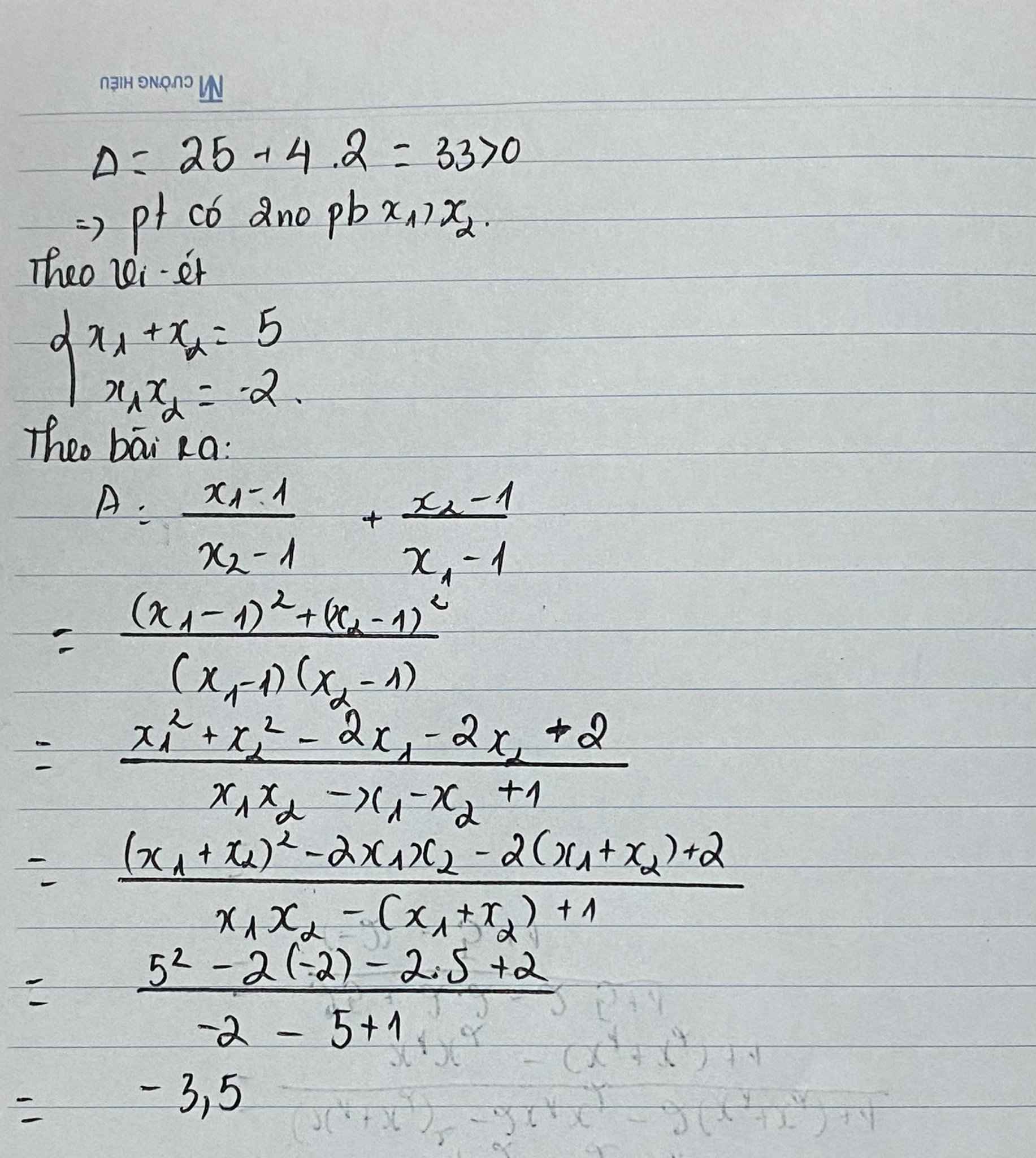CHo pt x-4x-3=0 có 2 nghiệm phân biệt x1,x2 không giải phương trình hãy tính giá trị của biểu thức A=\(\dfrac{x1^2}{x2}+\dfrac{x2^2}{x1}\)
Hãy nhập câu hỏi của bạn vào đây, nếu là tài khoản VIP, bạn sẽ được ưu tiên trả lời.


1. Theo hệ thức Vi-ét, ta có: \(\left\{{}\begin{matrix}x_1+x_2=-\dfrac{4}{3}\\x_1.x_2=\dfrac{1}{3}\end{matrix}\right.\)
\(C=\dfrac{x_1}{x_2-1}+\dfrac{x_2}{x_1-1}=\dfrac{x_1\left(x_1-1\right)+x_2\left(x_2-1\right)}{\left(x_1-1\right)\left(x_2-1\right)}\)
\(=\dfrac{x_1^2-x_1+x_2^2-x_2}{x_1x_2-x_1-x_2+1}=\dfrac{\left(x_1+x_2\right)^2-2x_1x_2-\left(x_1+x_2\right)}{x_1x_2-\left(x_1+x_2\right)+1}\)
\(=\dfrac{\left(-\dfrac{4}{3}\right)^2-2.\dfrac{1}{3}-\left(-\dfrac{4}{3}\right)}{\dfrac{1}{3}-\left(-\dfrac{4}{3}\right)+1}=\dfrac{\dfrac{22}{9}}{\dfrac{8}{3}}=\dfrac{11}{12}\)
\(1,3x^2+4x+1=0\)
Do pt có 2 nghiệm \(x_1,x_2\) nên theo đ/l Vi-ét ta có :
\(\left\{{}\begin{matrix}S=x_1+x_2=\dfrac{-b}{a}=-\dfrac{4}{3}\\P=x_1x_2=\dfrac{c}{a}=\dfrac{1}{3}\end{matrix}\right.\)
Ta có :
\(C=\dfrac{x_1}{x_2-1}+\dfrac{x_2}{x_1-1}\)
\(=\dfrac{x_1\left(x_1-1\right)+x_2\left(x_2-1\right)}{\left(x_2-1\right)\left(x_1-1\right)}\)
\(=\dfrac{x_1^2-x_1+x_2^2-x_2}{x_1x_2-x_2-x_1+1}\)
\(=\dfrac{\left(x_1^2+x_2^2\right)-\left(x_1+x_2\right)}{x_1x_2-\left(x_1+x_2\right)+1}\)
\(=\dfrac{S^2-2P-S}{P-S+1}\)
\(=\dfrac{\left(-\dfrac{4}{3}\right)^2-2.\dfrac{1}{3}-\left(-\dfrac{4}{3}\right)}{\dfrac{1}{3}-\left(-\dfrac{4}{3}\right)+1}\)
\(=\dfrac{11}{12}\)
Vậy \(C=\dfrac{11}{12}\)

Theo vi ét: \(\left\{{}\begin{matrix}x_1+x_2=6\\x_1x_2=8\end{matrix}\right.\)
Theo đề:
\(B=\dfrac{x_1\sqrt{x_1}-x_2\sqrt{x_2}}{x_1-x_2}=\dfrac{\left(\sqrt{x_1}-\sqrt{x_2}\right)\left(x_1+\sqrt{x_1x_2}+x_2\right)}{\left(\sqrt{x_1}-\sqrt{x_2}\right)\left(\sqrt{x_1}+\sqrt{x_2}\right)}\left(x_1,x_2\ge0\right)\)
\(=\dfrac{6+\sqrt{8}}{\sqrt{x_1}+\sqrt{x_2}}\)
Tính: \(\left(\sqrt{x_1}+\sqrt{x_2}\right)^2=x_1+x_2+2\sqrt{x_1x_2}=6+2\sqrt{8}=6+4\sqrt{2}=\left(\sqrt{4}+\sqrt{2}\right)^2\)
\(\Rightarrow\sqrt{x_1}+\sqrt{x_2}=\sqrt{4}+\sqrt{2}\) (thỏa mãn \(x_1,x_2\ge0\))
Khi đó: \(P=\dfrac{6+\sqrt{8}}{\sqrt{4}+\sqrt{2}}=4-\sqrt{2}\)

Áp dụng hệ thức Vi-et, ta được:
\(\left\{{}\begin{matrix}x_1+x_2=-\dfrac{6}{2}=-3\\x_1x_2=\dfrac{-3}{2}\end{matrix}\right.\)
Ta có: \(\dfrac{2}{x_1^2}+\dfrac{2}{x_2^2}\)
\(=\dfrac{2x^2_2+2x_1^2}{\left(x_1\cdot x_2\right)^2}\)
\(=\dfrac{2\left[\left(x_1+x_2\right)^2-2x_1x_2\right]}{\left(-\dfrac{3}{2}\right)^2}=\dfrac{2\cdot\left[\left(-3\right)^2-2\cdot\dfrac{-3}{2}\right]}{\dfrac{9}{4}}\)
\(=\dfrac{2\cdot12}{\dfrac{9}{4}}=24\cdot\dfrac{4}{9}=\dfrac{96}{9}=\dfrac{32}{3}\)

`1)` Ptr có: `\Delta=3^2-4.5.(-1)=29 > 0 =>`Ptr có `2` nghiệm phân biệt
`=>` Áp dụng Viét có: `{(x_1+x_2=[-b]/a=-3/5),(x_1.x_2=c/a=-1/5):}`
Có: `A=(3x_1+2x_2)(3x_2+x_1)`
`A=9x_1x_2+3x_1 ^2+6x_2 ^2+2x_1x_2`
`A=8x_1x_2+3(x_1+x_2)^2=8.(-1/5)+3.(-3/5)^2=-13/25`
Vậy `A=-13/25`
____________________________________________________
`2)` Ptr có: `\Delta'=(-1)^2-7.(-3)=22 > 0=>` Ptr có `2` nghiệm pb
`=>` Áp dụng Viét có: `{(x_1+x_2=[-b]/a=2/7),(x_1.x_2=c/a=-3/7):}`
Có: `M=[7x_1 ^2-2x_1]/3+3/[7x_2 ^2-2x_2]`
`M=[(7x_1 ^2-2x_1)(7x_2 ^2-2x_2)+9]/[3(7x_2 ^2-2x_2)]`
`M=[49(x_1x_2)^2-14x_1 ^2 x_2-14x_1 x_2 ^2+4x_1x_2+9]/[3(7x_2 ^2-2x_2)]`
`M=[49.(-3/7)^2-14.(-3/7)(2/7)+4.(-3/7)+9]/[3x_2(7x_2-2)]`
`M=6/[x_2(7x_2-2)]` `(1)`
Có: `x_1+x_2=2/7=>x_1=2/7-x_2`
Thay vào `x_1.x_2=-3/7 =>(2/7-x_2)x_2=-3/7`
`<=>-x_2 ^2+2/7 x_2+3/7=0<=>x_2=[1+-\sqrt{22}]/7`
`@x_2=[1+\sqrt{22}]/7=>M=6/[[1+\sqrt{22}]/7(7 .[1+\sqrt{22}]/2-2)]=2`
`@x_2=[1-\sqrt{22}]/7=>M=6/[[1-\sqrt{22}]/7(7 .[1-\sqrt{22}]/2-2)]=2`
Vậy `M=2`

\(F=x_1^2-3x_2-2013\)
Áp dụng Viét: \(\left\{{}\begin{matrix}x_1+x_2=-3\\x_1x_2=-7\end{matrix}\right.\)
Vì \(x_1\) là nghiệm của PT nên \(x_1^2+3x_1-7=0\Leftrightarrow x_1^2=7-3x_1\)
\(\Leftrightarrow F=7-3x_1-3x_2-2013\\ F=-2006-3\left(x_1+x_2\right)=-2006-3\left(-3\right)=-1997\)

Theo hệ thức Viet: \(\left\{{}\begin{matrix}x_1+x_2=-\dfrac{5}{3}\\x_1x_2=-2\end{matrix}\right.\)
\(\dfrac{x_1}{x_2-1}+\dfrac{x_2}{x_1-1}=\dfrac{x_1\left(x_1-1\right)+x_2\left(x_2-1\right)}{\left(x_1-1\right)\left(x_2-1\right)}\)
\(=\dfrac{x_1^2+x_2^2-\left(x_1+x_2\right)}{x_1x_2-\left(x_1+x_2\right)+1}=\dfrac{\left(x_1+x_2\right)^2-2x_1x_2-\left(x_1+x_2\right)}{x_1x_2-\left(x_1+x_2\right)+1}\)
\(=\dfrac{\left(-\dfrac{5}{3}\right)^2-2.\left(-2\right)-\left(-\dfrac{5}{3}\right)}{-2-\left(-\dfrac{5}{3}\right)+1}=...\)

\(x^2 - 4x - 3 = 0\) có 1.(-3) < 0
=> Phương trình có hai nghiệm phân biệt
Áp dụng hệ thức Vi-et có \(x_1 + x_2 = 4\) \(; x_1x_2 = -3\)
Mà \(A = \dfrac{x_1^2}{x_2} + \dfrac{x_2^2}{x_1}\)
\(= \dfrac{x_1^3 + x_2^3}{x_1x_2}\)
\(= \dfrac{(x_1 + x_2)(x_1^2 - x_1x_2 + x_2^2)}{x_1x_2}\)
\(=\dfrac{(x_1+x_2)[(x_1 +x_2)^2 - 3x_1x_2]}{x_1x_2}\)
\(=\dfrac{4.[4^2 - 3.(-3)]}{-3}\)
\(= \dfrac{-100}{3}\)